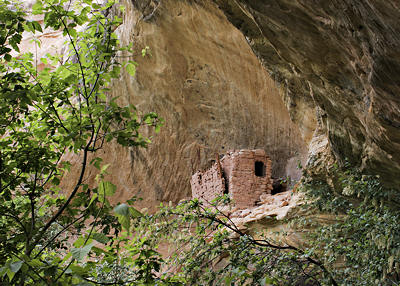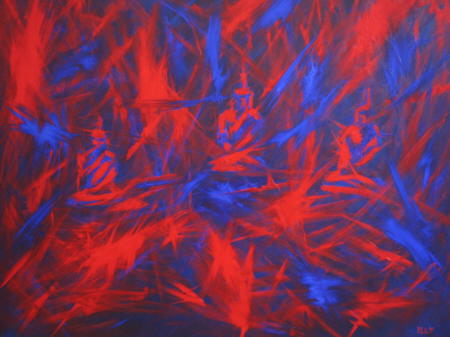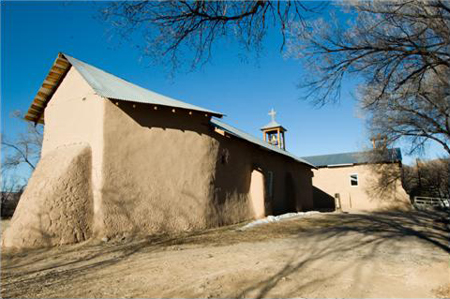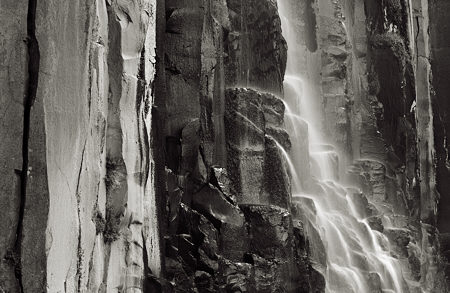It is said you can never step into the same river twice. The river flows on, the world changes. But I have a chance next month to return to Anasazi country where I photographed a year ago, and water seldom flows there at all. Conditions will probably be much the same, unless there’s a break from the hot, clear weather of last time. I will probably see some of the same ruins I photographed before, but I’m sure to see others as well. I am very interested to see what will come out of a return visit.
Archives for March, 2007
Tuning into the Art by MJ Illingworth
Last time I wrote a guest post here, it was very useful to receive everyone’s feedback and discussion. So firstly a big THANK YOU.
This time I’d like to dig a bit deeper, after all this is “Art & Perception”. So with that in mind, there are three paintings contained within this post; Above the Enchantment, Trikaya and Gaze of Hope, each of which will appear in an exhibition in April (all are 81cm x 102cm). The exhibition, titled “Insight”, is to encourage the viewer to look more deeply at what is seen and to contemplate, beyond taking things at face value. I’m therefore interested to understand what everyone perceives in these 3 paintings – you may recall that I use music during the painting process.
One Man’s Urban Decay Is Another Man’s Art Gallery

As I was wandering down 10th Avenue a couple of days ago, camera in hand, marveling at the amazing variety of shapes, colors and play of light I thought this is an artist’s guilty pleasure. I felt terribly lazy. I know I have a talented eye, but it is so easy to capture compositions and brilliant visuals in a matter of minutes compared to many 20th and 21st Century painters who struggled amd struggle for hours, days and even months to capture on canvas what an observant photographer can capture in a second.

Is time a factor in great art? And if not, why not? Picasso spit out paintings like a fecund rodent. Van Gogh produced something like 40 paintings in the last five minutes of his life–well–something like that. Other artists labor and struggle for months over one painting. The photographer is almost the Henry Ford Model T production line of work, especially with digital photography. Click. Click. Click. Delete. Click. Delete. Click, I actually find myself feeling guilty. I shouldn’t enjoy it so much and it should take much longer. This morning I was paid $1,000 plus a percentage for agreeing to post an online gallery with narration of 12 of my photographs in the Queer New York at Night series. Easiest and fastest $1,000 I’ve ever made. Guilt. And Jewish guilt which is the most refined vintage and vineyard of guilt, like a Vosne Romanee of guilt.
a reason for giving up photography
email from my friend Ginger with whom I share love of photography and interest in holistic medicine:
Thank you for sharing Richard’s photos and autobiographical narrative. It is courageous and inspiring at the same time. Art is and can be healing. For me the camera is still a bit of a shield…and so I’m never quite happy with what I do. A shield from being seen and conversely not seeing fully.
Paintings and messages
I have often found it difficult to frame a message by just painting a face. A lot of people ask me ‘OK, who is this – rather than – what are you trying to say by painting this face..’. Sometimes the title tends to reinforce the painting but few today tend to dwell on titles.
I got thinking about this more a couple of days back as I was reading a review in the New York Times about an exhibition “Citizens and Kings: Portraits in the Age of Revolution, 1760-1830” (underway at the Royal Academy of Arts in London, England). The portraits at the show tended to focus on the ‘message’ rather than the medium, movement or technique (as opposed to the majority of shows today which tend to focus on one or more of the latter). The article also made a reference to the fact that over time, the message tends to fade away while the techniques and talent employed in creating the work live on. While it is commendable that technique and talent stand the test of time (and should), exhibitions like these are relevant in showcasing the effects of social situations on paintings and how painters were influenced symbioticallyby the social milieu ultimately chronicling the society they lived in.
From the article in the NYT (I somehow got to it, but it might ask for a subscription):
“Yet this exhibition’s purpose is radically different: it is to dwell on the message, not the medium. Rather than celebrating the artists as such, it presents them as witnesses to the social and political convulsions of their times. It shows them recording a crucial moment of history as it unfolded.”
What does this painting tell you?
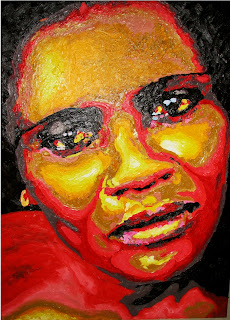
I am interested in your response before you look for my interpretation here.
Advice from the wife of a photographer
I was planning on posting this anyway, apropos of leaving on vacation with my wife, Robin, today. Then I saw Steve Durbin’s entry, and realized it would be the perfect follow-up. It’s a piece she wrote for my blog last year, but I think only 30 people saw it at the time. Her advice deserves a wider audience.
Advice to photographers’ significant others:
- When on a shoot or on the road, always bring food, water, and a book. If the light becomes “perfect” (usually early or late in the day, or if it’s overcast in just the right way), your photog will be captivated by it. Do insist on your right to go to the bathroom, be dropped at the hotel before the light comes in, or have your basic needs taken care of.
- Don’t take it personally when he says, “The light is beautiful on you.” You could be a rock, or a stump, or a wall. But he probably loves you anyway.
- Don’t take it personally when you become the “foreground element”. It’s not about you. You’re just the one that’s there.
- Do take it personally, in the best way, if you become the object of many studies. Photographers connect with the world through their cameras. It is another way of being known.
- You don’t have to like all of the work, if you like the photographer. Doug has one body of work that is too visually complex for my brain to process. None of this work is in the living room. If your person needs you to love every picture, send him to therapy. If you think you need to love every picture, go yourself.
- Get used to schedule changes. Your photog might find out on Tuesday that he’s going to Ireland for two weeks on Thursday. Have friends to fill in the gap. Accommodations I figured out included putting in a watering system for the garden, hiring people to do some of his tasks, and letting myself be pissed about the changes, until I’m not.
- Keep in contact. In most places in the developed world, there are local cell phones for sale. Speak often. Email. Whine. Say endearments. Listen to whining. Support. Ask for support. It’s good glue. We talk almost every day. I especially like to bask in Doug’s excitement when he’s on a shoot and it’s going well. He does bliss well.
- It’s okay to demand that the geek speak stops, when you’ve run out of patience for it. Especially if they’re talking about digital workflows. It’s rude for people to speak in a language not shared by others.
- When he comes back into town with 4,000 images to process, make some dates to connect, but don’t expect that he’ll be fully there until the images are on a disc and sent away. Then you can have the coming-back fight and really connect.
- It’s OK to play the wife role, whatever your gender, on occasion. I do this at openings and print sales and during the big post-shoot image processing. Other times, be who you are, more than wife. Doug is the wife at my conferences and book signings and when I’m writing. It’s OK to be flexible. Don’t get caught up in the role. It’s not a full enough identity for anyone.
- If you’re traveling together, don’t think you have to be joined at the hip. Pursue your own interests, then meet later. Do ask your person to leave the camera in the room or in the bag for a meal or an evening. Suggesting that making contact with you might allow your photog to “get lucky” can help this occur. It works for me.
- If he’s been gone for a long time, and you’ve had the house to yourself, expect conflict on re-entry. It’s normal. It’s predictable. Just have it. He’s invading your space, after all.
- Dont worry about the “Bridges of Madison County” scenario. You know how he really is.
- A story: Several years ago, outside of Banff, after a full day of shooting, the light changed and Doug became enchanted. I was really hungry. After 45 minutes, I demanded to be driven into town for food. Reluctantly, Doug packed up his gear, and we drove to a 2nd-floor sushi bar. I was facing the window. The light was magical. We ordered anyway. Before the fish came, I saw a rainbow over Mount Rundle. I said, “Doug, get your gear and get out there.” He did. 20 minutes later he returned. Three minutes later, the second rainbow appeared, arcing over the other. “Get back out there, now!” The waiter didn’t know what was going on. He kept asking if everything was alright. He didn’t understand my explanation: “My husband is a photographer.”
Robin’s blog (on therapy issues, for other therapists–you think photographer’s use geekspeak?) is at Trauma & Attachment.
Art and solitude
My landscape photography has grown out of activities I would engage in anyway. I’ve always loved hiking, be it in the mountains, the woods, the desert — anywhere. These days I usually have my camera along. Sometimes I’ll be in an area I suspect might be interesting photographically, but usually I’m just in a place I want to explore. Either way, I don’t feel cheated if I take no pictures at all, and I’ve never had a bad time. But I have found a difference between productive and unproductive outings. The key predictor is whether I’m alone.
